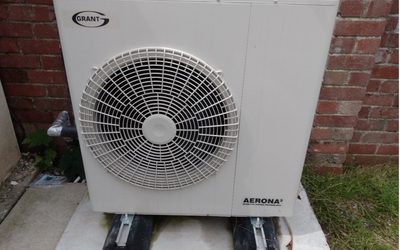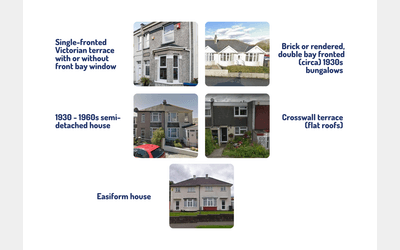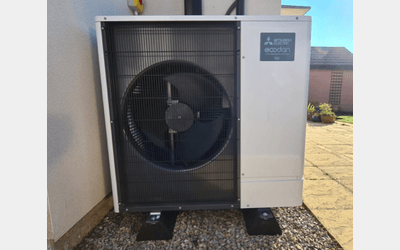- News /
- Results are in on heat pump research
Results are in on heat pump research

Thanks to funding from MCS Charitable Trust, we've been researching how well air source heat pumps could work in five common Plymouth house types.

Weaning ourselves off gas boilers will be a significant change required on the journey to net zero and heat pumps will have an important part to play in lots of our homes. We wanted to see how well heat pumps might work so that we can give good advice on heating homes efficiently.
Heat pumps could replace other heating systems and help reduce carbon emissions from heating homes.

The findings are from a very small sample size, but we have looked at each of the properties in detail and the work presented the following headline findings:
- In all properties it was possible to install a heat pump. The most significant challenges were the positioning of the pump and the hot water tank, but these issues were not insurmountable
- In all cases the existing pipework and most of the radiators could be reused, if houses also had improvements such as increased insulation, to allow the system to perform at its best
- In all properties an increase in fuel bills was projected when compered to an efficient gas boiler. However, energy bills have changed dramatically in recent months and may well continue to change so this warrants further investigation to take account of these changes.
- In most cases heat pumps were cheaper to run than night storage heaters. In all but one terrace property, with the properties in their current condition, heat pumps proved cheaper to run by an average of 18% in terms of annual fuel bills than night storage heaters. ;
- However; the cost of installing storage heaters is likely to be significantly less than installing heat pumps, and with the three system build properties only 3-16% more expensive to heat with storage heaters than heat pumps, this suggests further consideration of upfront cost vs. running cost would be valuable.
- In all cases storage heaters resulted in in higher "Energy Use Intensity" figures than a heat pump, which could be worth further consideration in terms of the impact on the grid as part of decarbonisation of heat, though the impact will be heavily dependent on energy mix on the grid, with much of this load due only to be at night with storage heaters
- Heat pumps were on average 13% more expensive to run than storage heaters once the structure of houses were improved to reduce heat loss (albeit to high standards). This was based on SAP 2022-unit costs rates that show the current benefit of reduced nigh-time ‘off-peak’ rates. As we move away from economy 7 tariffs towards 'time-of-use' tariffs and with increased use of smart controls, then a more sophisticated comparison of how predicted fuel bills for ASHP and storage heaters will be required.
- Notably, in five out of eight cases night storage heaters were also cheaper than gas in terms of annual fuel bills once the thermal performance of the property had been improved.
- Surprisingly, the two Easiform properties showed the lowest expected increase in bills for replacing a gas boiler with an ASHP. First built in 1919, there are reported to be 85,000 Easiform properties in the country with most built between 1946 and 1970. The properties are built with cast-in-situ concrete. The prevailing perception around these, and other system ‘non-traditional’ build properties of this era is they perform poorly on energy efficiency terms. However, we found the opposite, and they also had some of the lowest heating demand figures (before and after retrofit improvements). Although it is of note that in both cases this considers the benefit of having cavity wall insulation as well as external wall insulation on these properties.
- In all cases the ASHP size proposed based on current thermal performance standards was likely to be too large once properties had been fully retrofitted. Property heat load is important in sizing the appropriate heat pump. As such, we considered the potential for low carbon retrofit in this study and a 'fabric first' approach was taken wherever possible. This indicated a potential for an average reduction in heat load of 44% achievable with the retrofit measures recommended. This shows the importance of heat pump sizing relative to retrofit plans. Customers need to be advised carefully on their retrofit plans so they can make well informed decisions about the most effective order of the work they have done.
